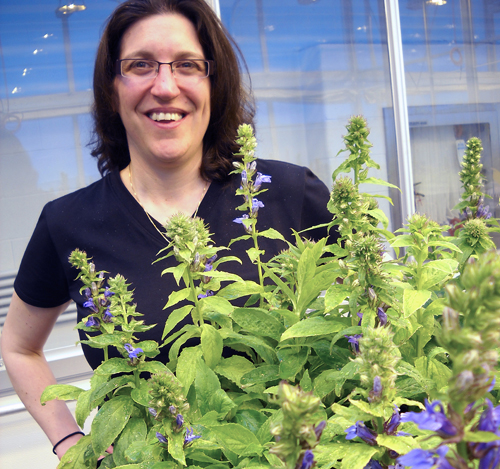
There’s a battle of the sexes going on in your garden. Learning more about that fight might help not just gardeners but plant breeders and crop farmers feeding the world, says a U of G evolutionary ecologist awarded an American sabbatical fellowship this year.
Beginning in September, Prof. Christina Caruso, Integrative Biology, will spend nine months at the National Evolutionary Synthesis Center (NESCent) in Durham, N.C. She’s the only Canadian biologist among 25 scientists worldwide funded by the group this year.
Besides hoping to help breeders and farmers, Caruso expects to probe at the central but poorly understood role of genetic conflict in the evolution of plants and animals, and how ecology affects that conflict.
She studies a kind of sexual intrigue in flowering plants, especially Lobelia. Many gardeners favour the scarlet ornamental blooms of one perennial species, L. cardinalis, commonly called cardinal flower. But it’s a close relative that interests the Guelph biologist. L. siphilitica, or great blue lobelia, is grown by gardeners in eastern and central Canada and the United States. Caruso grows thousands of the plants in the rooftop greenhouse of U of G’s science complex to explore their unusual sex life.
In almost three-quarters of flowering plants, individual flowers are hermaphrodites, containing both male and female parts. Other plants separate their parts, confining them to different flowers or even distinct plants. Plants with male-only or female-only flowers are called dioceous (Greek for “two households”).
For Caruso’s rooftop plants, it’s not an either/or world.
She’s interested in a few species – only about seven percent of flowering plants – whose flowers are both hermaphrodites and female-only. Besides lobelia, other plants using this system include the flowering plant Silene (commonly called campion or catchfly), as well as wild relatives of cultivated strawberries and squash.
In all plants, a kind of contest plays out between genes in different parts of the organism’s cells that disrupt or restore pollen production.
In flowering plants, one group of genes inside the cell nucleus directs the making of pollen. Other genes occupy the mitochondria, where the cell makes energy. Mitochondrial genes, also called cytoplasmic male sterility genes, can disrupt pollen production so that flowers produce only seeds and not pollen. That’s what happens in the female-only form of Lobelia.
Usually the nuclear genes win the contest, turning pollen production back on and allowing the flower to make both seeds and pollen. Caruso says one mystery is how female-only flowers manage to pop up at all. “That’s why it’s really hard to explain. These females should be at a huge disadvantage,” she says.
Breeders and farmers exploit the results of the contest to make pure hybrid seed.
As an evolutionary ecologist, Caruso is also interested in how this system has helped drive the evolution of non-crop plants, including helping new species to arise.
She plans to look at how these genes spread in wild plant populations. She’ll study the role of ecology by pulling together research in the evolution of breeding systems, pollination and herbivore defence. Most biologists studying this system have looked at the genetics of male fertility restoration rather than the influence of ecology.
Another puzzle posed by Lobelia is its “harem” effect. Look at a map showing L. siphilitica’s natural range. In Ontario and the northern states, most of the plants are hermaphrodites. The further south you go, the more female-only flowers you find. In southern Indiana, about 80 per cent of the plants are female-only. Caruso hopes to help explain that distribution.
She works with plant biologists Andrea Case at Kent State University in Ohio and Maia Bailey at Providence College in Rhode Island.
NESCent brings together scientists from various disciplines to look at evolutionary problems in organisms. NESCent scholars have studied topics such as evolution of tooth shape in mammals, insect evolution and biological computing.
This year’s awards will go to 25 recipients, mostly from the United States but also from Australia, Canada and the United Kingdom.
The centre is jointly run by Duke University, the University of North Carolina at Chapel Hill and North Carolina State University, and is sponsored by the National Science Foundation.
Caruso’s husband, Prof. Hafiz Maherali, Integrative Biology, and their daughter, Hana, will accompany her to North Carolina.